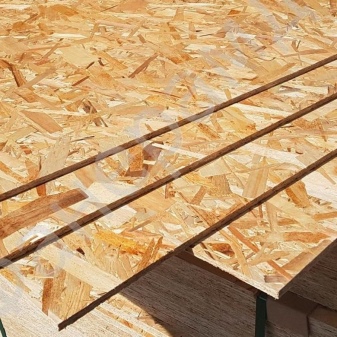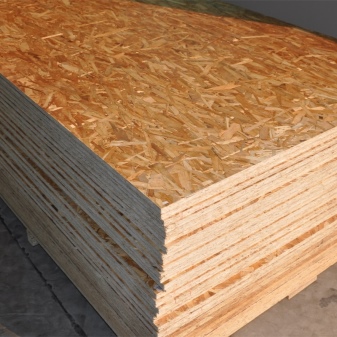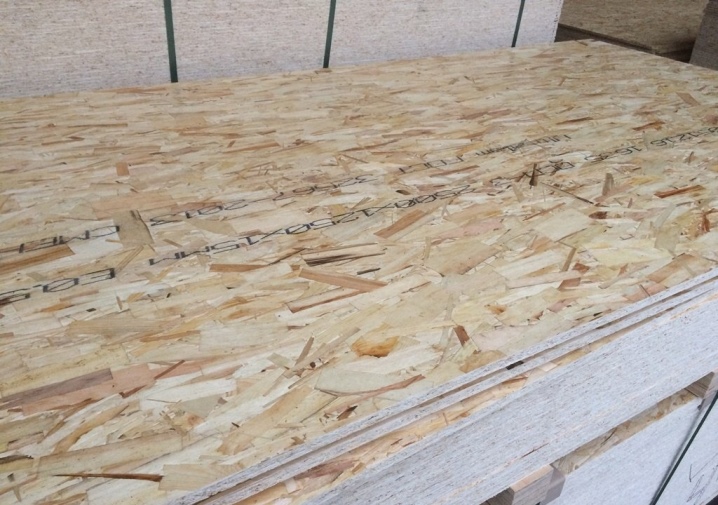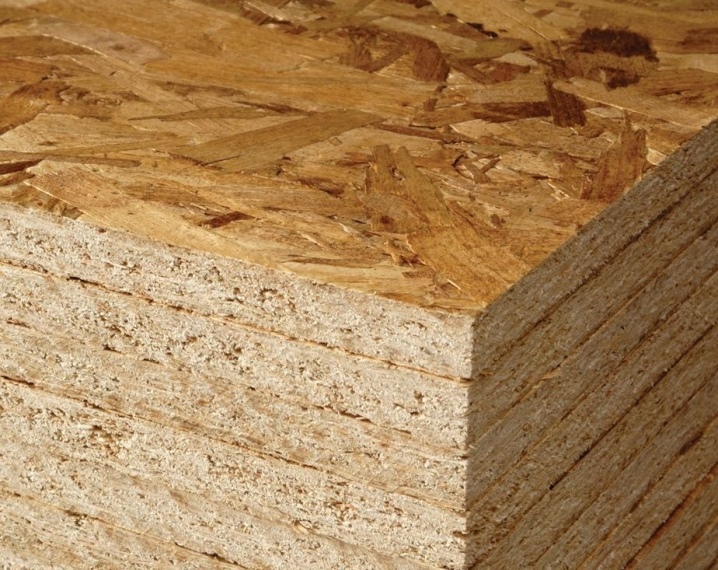All about moisture resistant OSB plates

OSB panels made from oriented strands have different properties, technical and operational characteristics. The highest quality materials are considered to be OSB-3 and OSB-4 - these are moisture resistant panels with a minimum swelling coefficient of 10-15%. We will understand the features of moisture-resistant plates, methods of their production, types and areas of application.


Main characteristics
Moisture-resistant OSB plates are a structural material that is produced in Russia in accordance with the regulations of GOST 32567-2013. For its manufacture, wood shavings (at least 90%) of various sizes are used. In this case, the length of the chips should not exceed 20 cm, the width - 4 cm and the thickness - 1 mm. The panels consist of several layers of shavings, and each of them is laid in different directions. Thanks to this manufacturing technology, the material is strong and durable.
Waterproof OSB panels paint and stick well. Due to this feature, the consumer can easily change their appearance. For OSB, it is allowed to use high-quality paints suitable for painting natural wood products. OSB boards are easy to process. They are sawn, cut, polished and drilled quickly and effortlessly using hand or electric carpentry tools.

Let's list the main characteristics of moisture resistant OSB boards.
- High bending strength. For waterproof materials, the value ranges from 3500 to 4800 N / mm2.
- Light weight. The weight of the panels directly depends on their size. Depending on the dimensions, the weight ranges from 12 to 46 kg. Due to its low weight, the transportation of material does not require the hiring of specialized equipment. And also due to the low weight, the load on the base of the building structure is reduced.
- Density not less than 650 kg / m3 (approximately the same as natural wood).
- Uniformity of the material along the entire perimeter. There are no air voids or delamination inside the panel.
- Good retention of fasteners, due to the high density of the building material and its fiber. When working with panels, it is allowed to use all types of fasteners that are suitable for wood-based tile materials.
- Fire safety. Waterproof OSB panels are classified as flammability class G4. This class includes fire hazardous materials. To reduce the level of flammability, manufacturers treat the panels with special substances.
- Resistance of moisture-resistant sheets to temperature influences. Even with sharp jumps in temperature, the building material does not exfoliate and does not lose its operational properties.


OSBs have a weak biological stability - with a long stay in conditions of high humidity, the risks of mold on their surface significantly increase.

The disadvantages of a moisture-resistant composite material include its toxicity and harmfulness. The technology of its production provides for the use of formaldehyde and melamine-formaldehyde resins. These substances, released into the environment, negatively affect human health.
The most dangerous moisture-resistant boards include products with an E3 emission level (formaldehyde emission ranges from 1.25 to 2.87 mg / m³). The production of such materials is prohibited in European countries.Building materials with emission class E1 and E2 are considered the safest for health. More formaldehyde is released into the environment in the first year of use.
What is better than plywood?
Plywood board and OSB-boards are building materials similar in manufacturing technology and technical parameters. Plywood is made from wood veneer, its thin layers are glued together using an adhesive with formaldehyde compounds. The veneer planks have a more aesthetic face, so they can be used for exterior finishing work.

However, OSB boards have some better operational properties and technical qualities in comparison with plywood. For example, they are lighter. Due to the low weight, it is more convenient to work with sheets, moreover, they have a lower weight load on the building structure.

Fasteners are easier to sink into oriented strand sheets. In plywood boards, experienced builders advise to pre-make holes before screwing fasteners - this leads to additional time costs.
Compared to plywood, OSB boards have better sound insulation. And also sheets of oriented shavings will cost significantly less than plywood boards. With a limited budget and the need to finish large areas in order to save money, it is recommended to give preference to panels made of shavings.

How to distinguish from the usual?
Many buyers are wondering how to distinguish moisture-resistant panels from non-moisture-resistant materials. In most cases, moisture resistant planks are laminated or varnished. The front side of the laminated panel is covered with a wear-resistant film that increases the moisture resistance of the material.

How are slabs made?
The main raw material in the production of OSB boards is hardwood shavings. For these purposes, at the stage of sorting, illiquid small-sized trunks are selected. They are sawn into short workpieces, which are then cut into chip bands on special machine equipment. On such units, it is possible to set the required dimensions of the future chips.

After drying the prepared raw materials in bunkers, the chips are sorted into large and small fragments. This is the preparatory stage for the manufacture of OSB.
Further production technology includes certain sequential actions.
- Mixing the main raw material with the adhesive. The chips that have passed the sorting are mixed on special equipment with phenolic and isocyanate components. Due to the adhesives, the finished sheets acquire the necessary rigidity, strength and water resistance. The material, mixed to a homogeneous mass, then enters the drums, where resin and paraffin are also fed.
- Forming and styling. It is carried out on specialized lines, the design of which provides for pressure rollers, scales, magnets. The latter are necessary to trap foreign inclusions. At the same stage, the chips are oriented - in the first layer, they are laid along the long side of the sheet, and later in the transverse direction.
- Pressing. The process is carried out on pressing equipment at a pressure of 5 N / sq. Mm and a temperature of 170 to 200 degrees.

The last stage is cutting the canvases moving along the tape into sheets of the required size. Finished products are packed and sent to the warehouse - there they are "laid down" for a certain time, which is necessary for the complete hardening of resinous substances.
Description of species
Manufacturers offer several varieties of oriented strand board. They are polished - with a smooth surface without external defects and flaws. Products with a flat side are intended for flooring. Also found on the market tongue-and-groove OSB-panel. Its distinctive feature is the presence of locks at the ends, with the help of which the sheets are stacked close to each other without the formation of cracks.

By brands
OSB are divided into types depending on the strength class and resistance to moisture:
-
OSB-1;

-
OSB-2;

-
OSB-3;

- OSB-4.

OSB-1 is the cheapest material with the least moisture resistance. It is not recommended to use it outdoors, for the construction of load-bearing structures, as well as for finishing in rooms with high levels of humidity (in the bathroom, toilet, kitchen). It is most often used for leveling walls in dry rooms, in the manufacture of furniture items.
OSB-2, in contrast to OSB-1, has greater rigidity and strength. They are allowed to be used in the construction of load-bearing structures. Due to their budgetary cost, they are often used to equip rough floors in dry rooms. However, due to the high coefficient of swelling, such sheets are not recommended for use at high humidity levels.
OSB-3 - moisture resistant material, with increased rigidity and strength.
OSB-4 is the highest quality and most expensive building material. It is distinguished by the maximum indicators of rigidity and strength, as well as the smallest swelling coefficient. It is recommended to use such panels as structural materials. They can be used for finishing the facades of buildings and in rooms with a high level of humidity.

By size and weight
OSB panels have standard dimensions. Their thickness is:
- 6 mm;
- 9 mm;
- 11 mm;
- 12 mm;
- 15 mm;
- 18 mm.

Its weight directly depends on the thickness of the product. The thinnest panels weigh 12.5 kg and the thickest ones weigh 35 kg. The most popular are sheets with dimensions of 2500x1250 mm, 1220x2440 mm and a thickness of 9 to 12 mm.

Applications
Oriented chip sheets are used as structural and finishing building materials. With their help, walls are sheathed inside or outside the room. With the right choice, the panels will be in harmony with various decorative cladding. Depending on where the slabs will be used (for outdoor work or for interior decoration), sheets with the optimal brand are selected.


Oriented strand panels are used for screed floors on concrete or timber substrates. In lightweight buildings, they are used as an independent finish.

Let's consider other areas of application.
- As a base for roofing. The slabs are characterized by increased strength and rigidity, thanks to which they are able to withstand strong wind gusts.
- In the manufacture of I-beams. Due to their good rigidity, the slabs make any building structure reliable.
- Construction of temporary formwork when working with concrete mortar. For multiple use, preference is given to sanded or laminated sheets.
- Manufacturing of containers for the transportation of goods of any size.
- Furniture manufacture. Moisture-resistant OSB is used for the manufacture of furniture cases, decorative structural elements (for example, chair backs), back slats of cabinets, chests of drawers.
- Construction of temporary housing.
- Manufacturing of production racks, shelves, counters.




OSB boards are widely used in the construction industry. At the same time, they cover all areas of construction - from private housing to industrial.














The comment was sent successfully.